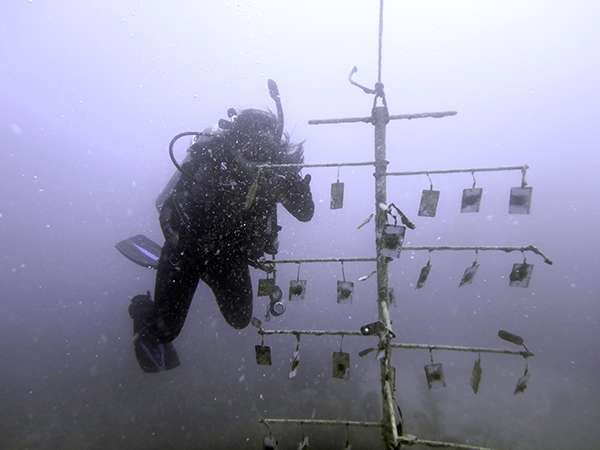Marine Scientists and Astronauts to Together Create the World's Deepest Coral Nursery
Published on by Water Network Research, Official research team of The Water Network in Technology
Florida Keys Marine Sanctuary is growing pieces of endangered corals on a 10 tree-like structures made of PVC pipes rise up from the ocean floor, adorned with plastic cards that hang from fiberglass branches.
This group of makeshift trees could help solve one of the greatest environmental problems facing the world's oceans today—the loss of coral reefs.
The structures are divided into two groups not far from FIU's Aquarius Reef Base. Scientists call them nurseries, a place where they grow new corals. One resides at 90 feet below the ocean surface, the deepest coral nursery in the world.

FIU biology Ph.D. student Valeria Paz helps conduct research on coral reef restoration.
Credit: Florida International University
The world's coral reefs are threatened by fishing, pollution, global warming and even sunscreen. Because these disturbances affect shallow reefs more than deep reefs, marine scientist Mauricio Rodriguez-Lanetty is studying whether corals in deep waters can be used to repopulate imperiled reefs in shallow waters. He and the members of his lab have partnered with the Coral Restoration Foundation to create the nurseries.
When it came to the actual labor of "planting" the trees, the team sought the help of astronauts. Establishing a nursery at those depths would be difficult to accomplish on routine dives because of time limits designed to avoid decompression sickness. But because of FIU's Medina Aquarius Program, which houses the world's only underwater research laboratory, people can live and work underwater for days and weeks at a time.
"Saturation diving allows us to conduct research that can't be done anywhere else in the world," Rodriguez-Lannetty said. "We wouldn't be able to study deep coral reefs without the support of Aquarius. It would be impossible."
When astronauts from NASA, the European Space Agency and the Japan Aerospace Exploration Agency descended on Aquarius for a training mission in 2015, they took the trees with them. The scientific project was a perfect exercise for the astronauts to test communications equipment in an isolated and extreme environment. They deployed the trees under the direction of Rodriguez-Lanetty and named the nurseries Mercury and Atlas.
The research being conducted at Aquarius could be a first step in finding solutions to one of the oceans' greatest environmental threats.
Source: Phys.org
Media
Taxonomy
- Environmental Health
- Environment
- Marine
- Aquatic Environment
- Marine Technologies